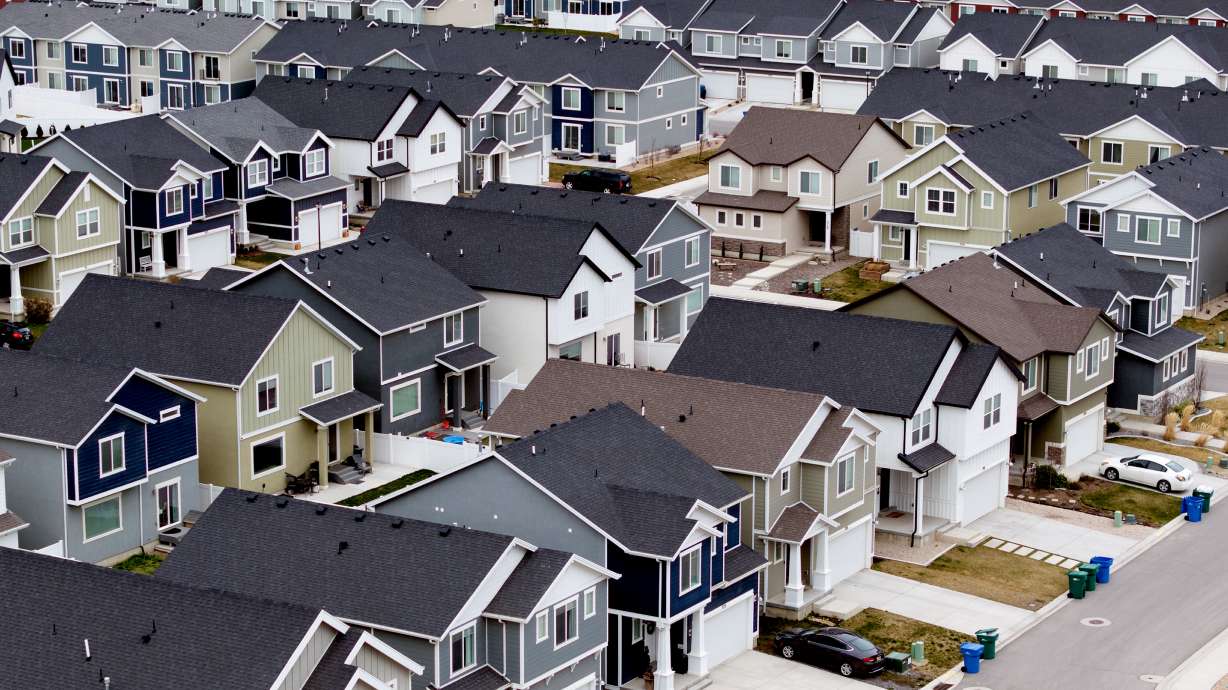Estimated read time: 4-5 minutes
This archived news story is available only for your personal, non-commercial use. Information in the story may be outdated or superseded by additional information. Reading or replaying the story in its archived form does not constitute a republication of the story.
SALT LAKE CITY — No other state is padding its housing stock like Utah when it comes to housing unit percentage growth.
The Beehive State's housing stock jumped 2.5% between 2022 and 2023, the Census Bureau reported last week. It topped the nation in the category for the third straight year.

Yet despite this growth, residents and visitors alike may have noticed there aren't as many single-family homes or multifamily projects in 2023 as a few years ago. Indeed, federal data shows the number of new privately owned housing units dropped again in 2023 after a massive surge in 2021.
So while Utah's housing stock continues to rise at a faster clip than any other state, the Census Bureau — analyzing building permit data — reports new private ownership housing has plummeted from a record-high 39,058 units in 2021 to 31,749 in 2022 and 25,361 in 2023.

Last year's total was a 20% dip in year-over-year and a 35% drop from two years ago.
What's the deal?
A few different factors are playing into these differing trends; however, these numbers are mostly emblematic of the state's growth and the impact that the COVID-19 pandemic had on the national housing market, says James Wood, Ivory-Boyer senior fellow at the University of Utah Kem C. Gardner Policy Institute.
Growing houses
In a 2019 report, Wood wrote that new housing units outnumbered Utah's population growth from 1970 to 2010. That trend shifted in 2010, creating a major housing shortage the state is still sifting through.
Even as the number of new single-family homes or multifamily projects grew every year from 2010 to 2021, Utah wasn't building houses fast enough to meet the growing population.
More people lived with roommates, and there were more multigenerational households over that time. This helped residents afford housing and helped fit all that growth into the housing supply. This, Wood says, lasted until about 2018, when the number of new housing units finally exceeded households.
The state's housing gap began to slowly shrink.
A pandemic ripple effect
Then came 2020. Utahns may remember that as they navigated through public health measures, the Federal Reserve cut the interest rate to 0% to avoid major economic impacts as the COVID-19 pandemic ravaged the country.
The rates remained historically low throughout most of the next two years, creating "artificially high numbers" in the housing industry, Wood explains. Mortgage rates slipped under 3%, something that rarely happens, making homeowning a little more affordable. Contractors were also able to take on more projects because it was easier to finance with the low rate.
It sparked a firestorm of buying and building that even exceeded the state's growth, powering the new 39,058 private units reported in 2021. The lower rates also helped create more apartment developments that also chiseled away at housing deficits.
"You had a really bullish environment in late 2020 into 2021 because of very low interest rates, and developers had lots of money, lots of liquidity and — consequently — you had a lot of building," Wood said.
An inverse trend emerged in 2022. The Federal Reserve raised interest rates to well above the pre-pandemic level to combat record inflation that jolted the country. Homebuyers and homebuilders alike became skittish as mortgage rates doubled, and the cost to approve construction skyrocketed, too.
As Wood puts it, it's easier for homebuilders and buyers to pull out of projects because of the higher prices, so that's likely why the number of private home permits in 2023 dropped 35% over two years. Larger apartment complexes were impacted by this too, but they were more likely to get funds so that could explain why the state's overall housing stock is still growing.
"(The data is) just the reflection of the impact that interest rates have on residential construction," Wood said, calling the 2022 and 2023 slowdown an "adjustment" of the 2020 and 2021 housing explosion.
This trend is also playing out nationally. Nearly every state grew in 2021 before most dropped in 2022, according to the Census Bureau. Only eight states ended up with privately owned unit increases in 2023, led by Alaska's 62% jump — but that was just because there were 359 more projects than in 2022.
"It comes down to mortgage rates and interest rates," Wood said.
What happens now?
Housing is an issue not going away anytime soon, especially as the state continues to grow in population.
The state likely needs 28,000 new housing starts each year to keep pace with growth, Steve Waldrip, senior adviser for housing strategy and innovations to Gov. Spencer Cox, said in March. The governor said last week Utah is working on a statewide housing plan that aims to create more starter homes, reducing the housing deficit and the cost of homes.
Yet the state's housing deficit probably grew again with 2022 and 2023 drop-offs, Wood says. He expects an "equilibrium" in the coming years as growth and building even out, and the market returns to normal. But Utah's ongoing growth will continue to create a housing demand.
The housing construction to meet the demand? Utah may be poised to receive more smaller homes and condominiums to keep up the pace while cutting costs for developers, Wood adds.
As the last few years have shown, mortgage and interest rates may factor in all of this, too.









